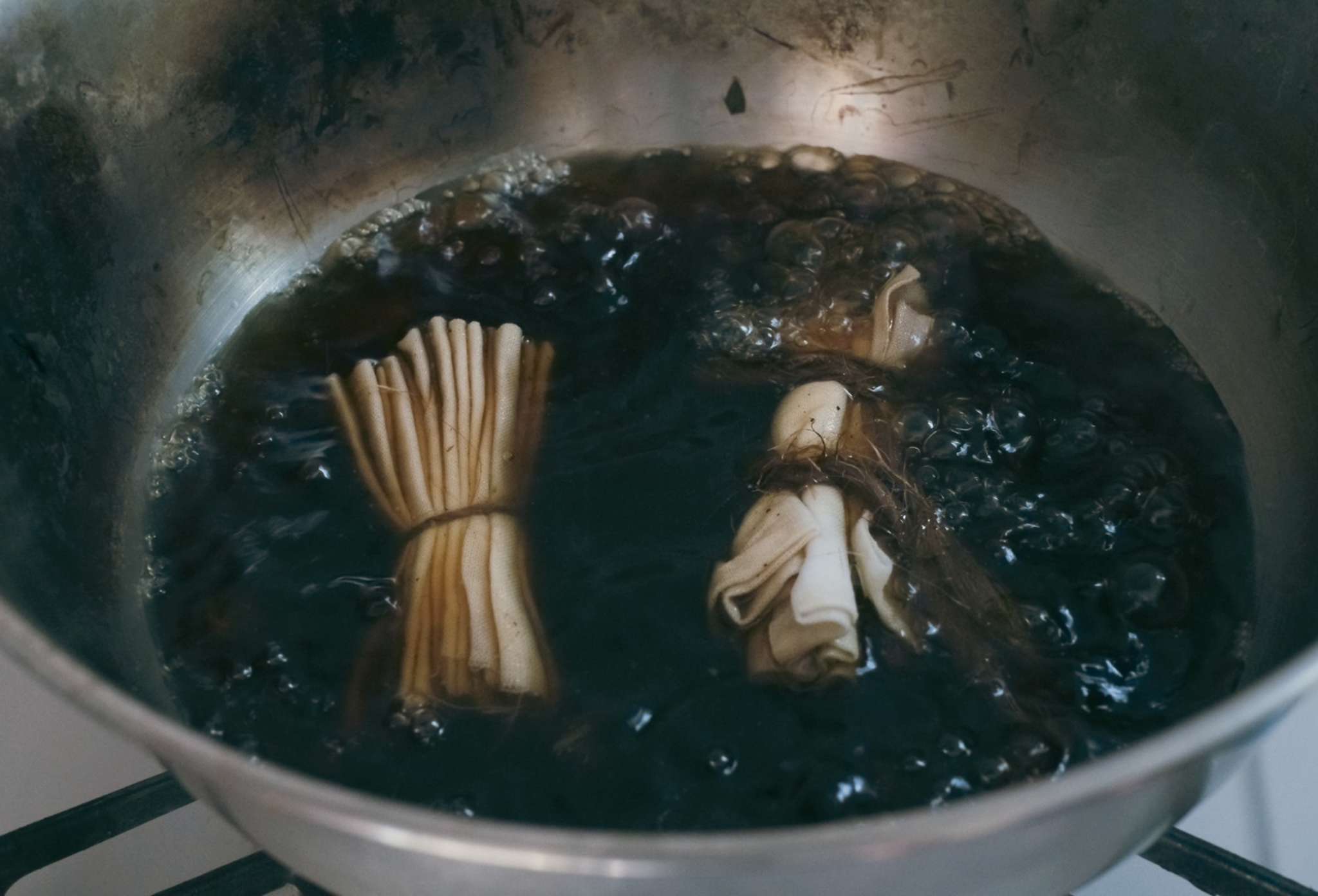Creating a new direction with natural colors— Shun Hatano (dye artist)
The southern tip of the Miura Peninsula, surrounded by Sagami Bay, Tokyo Bay, and the Pacific Ocean. Shun Hatano, a dye artist, settles quietly on a hill surrounded by trees. The hill has a good view overlooking the sea and fishing port, all while being in close proximity to a variety of wild animals and plants. Since collaborating with Hikari Mori for lifestyle shop “city shed” in 2020, both Shun and Hikari have bonded over their mutual enthusiasm and viewpoints on manufacturing, becoming friends in the process. While contemplating the cultural background of tie-dye, they continue to explore the possibilities of dye by further developing traditional techniques.

Shun, who has been exposed to different cultures while buying used clothes in the US, has only been dyeing for about four years. He was invited by a friend to open a tie-dyed clothes stall at a flea market. Word spread about Shun’s signature tie-dye pattern, resulting in production offers from brands, second-hand clothing stores, and offers to do custom work for musicians. He was asked to treat newly made clothes while receiving this wide range of requests.

“At first, I was happy to get compliments on my work. But due to a conversation I had with that friend who owns a second-hand clothing store, I started to care about dyeing something that couldn’t be made into a sellable product due to dirt or stains. I felt uncomfortable being asked to produce new t-shirts for brands so intentionally, I never made new ones from scratch. It was from here that I decided to only work with brands who shared that same thought process.”
Shun says, “I don’t think about making something specifically just to sell, right?” In line with that idea and bring his style closer to more modern tastes, Shun chose a method of plant dyeing, to show how colors can be beautifully produced from what was already available naturally.

The Flowers Within a 5km Radius
“Everyone is pleased because weeds are used. People in town bring a lot of them when we say we’re dyeing with mugwort and they go out with the experiments all over the city.” Everyday Shun works on developing ideal color creation by researching and extracting from materials that are already existent around the atelier. While flowers (and therefore colors) change with the seasons, Shun limits his chosen resources to whatever can be found within a 5km radius. The reason for this is that he wants us to question the value of things that are erased due to our prioritizing convenience, as opposed to the simple joy of a chance encounter.”

“Originally, I buy things that leave an impression on me. But right now I think everyone spends money without much consideration. I stopped buying items worth JPY100 a year ago. I often think about how convenient and inconvenient it is at the same time. Due to the idea of JPY100, it has become impossible to build local factories and now we’re surrounded with JPY100 items. As things are given the token value of JPY100, only JPY100 quality items becomes available. I would love if more people could become more conscious of “good things” that they’re involved in and have been put out into the world.”
Recently, I’ve tried to make things that would remain purchasable to people two years after production.
“Sometimes, there are order events at which I accept orders to tie-dye and return used clothes anew, but as it’s been two years since I’ve started, I decided to change up the rule and do the re-dyeing for free. Because I make them myself, I’m happy to take responsibility for it. I’m glad to see the work two years later when they’re quite worn in. It’s fun to do it and watch the change. I know I shouldn’t think about sales too much but I would love to continue this for another ten years.”

The Initial Urge to Shop
Shun is from Awaji Island. Shopping takes an hour and a half on the bus and finally arrives in Kobe. When he was in elementary school, he could only travel to the mainland by boat. He says he can't forget the feeling he had when he was headed to these shopping destinations, money in hand, with excitement. But he doesn't waste his money without thinking; he wants to keep the habit of carefully deciding what he wants before buying it, so he keeps a distance from Tokyo.

“Rather than buying something that appears to be fake, I’d rather try making it myself. If I think this way repeatedly it will reduce how much I buy as much as possible and affect my own manufacturing. I’m learning now how to dye from a more high-tech local dyeing shop. The brand I’m currently working with has afforded me the patience to go all out with experimentation in search of a really high quality tie-dye that only I can offer, as opposed to a price quota basis. As such, I’m doing as much research as I can so we can propose new dyeing methods and colors, adding to the plant dye method I had previously worked on. Now, we’re burying denim in four different locations on the Miura Peninsula, chosen for the different soil contents at each spot such as red clay, black clay, and water retention. We’ve buried the fabric and leaving it underground for a year to see the color that’s produced as a result.”
The goal is to no longer require dyes.
Shun Hatano’s challenge is to continue forward in a world that is moving in a good direction.
Photo: Arata Funayama
Text: Yuka Sone Sato
Design: Mammy Horie
Translation: Kelli Yeunh









